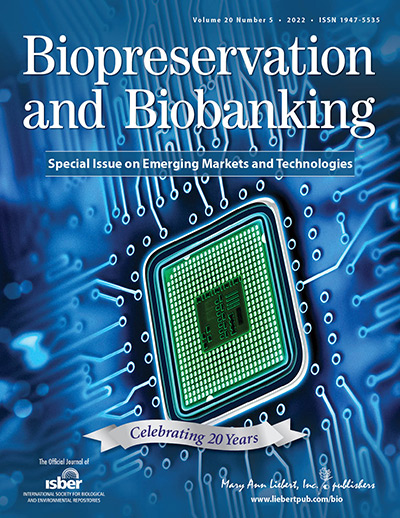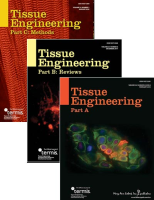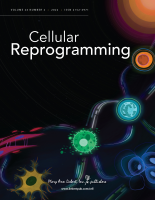Announcements
-
Call For Papers
As ISBER marks 10 years of affiliate collaboration with the Australasian Biospecimen Network Association, Biopreservation and Biobanking is planning a special issue intending to showcase the truly unique and innovative work within the region.
Submit Today
-
Article Collection: Data Sharing
Over the past several years, there has been greater recognition of the importance of data sharing in research. The benefits of broad data sharing include permitting secondary data analysis, optimizing resource use, avoiding unnecessary study duplication, ensuring reproducibility, and increasing statistical power. However, researchers may be reluctant to share their data, and current mechanisms for sharing human data through Data Access Committees generally rely on manual workflows. Recent papers published in Biopreservation and Biobanking explore the critical issue of incentives for data sharing and the use of automated decision support tools to enhance the efficiency and effectiveness of decision-making by Data Access Committees for access to data.
Read the Collection
Aims & Scope
Biopreservation and Biobanking is the first journal to provide a unifying forum for the peer-reviewed communication of recent advances in the emerging and evolving field of biospecimen procurement, processing, preservation and banking, distribution, and use. The Journal publishes a range of original research, review and special feature articles focusing on current challenges and problems in biopreservation, and advances in methods to address these issues related to the processing of macromolecules, cells, and tissues for research. Ideas and practical solutions are discussed relevant to improved quality, efficiency, and sustainability of biobanks/repositories, as well as their management, operation and oversight. The journal also welcomes articles that explore the ethical, legal, and societal considerations surrounding biobanking and biorepository governance and operation. Finally, the Journal highlights the Emerging Markets and Technologies that are influencing biobanks and their impact on society. The solutions presented here are anticipated to help drive innovation within the biobank community.
Submitted manuscripts should present novel and/or broadly important findings or concepts that are influential to the field of biopreservation and biobanking. Papers that simply describe the profile of a biobank, it’s holdings and/or distribution efforts and are not supported by in-depth research data or novel findings or concepts that are more broadly applicable to other biobanks are not generally deemed acceptable for publication in the journal.
Biopreservation and Biobanking coverage includes:
- Biospecimen preservation and handling topics including but not limited to:
- Biospecimen preservation including the evaluation of pre-analytic variables and methods validation
- Cellular and molecular mechanisms of biopreservation
- Mechanisms of cryoinjury and its prevention during cooling and warming processes
- Cryopreservation of living cells, tissues, and organs
- Novel biopreservation technologies
- Optimization protocols for storage, biopackaging and transport of biospecimens
- Freezing and vitrification mechanisms and their applications in biopreservation
- Stem cell banking
- Novel methodologies for gamete cryopreservation to support species conservation
- Organoid systems
- Natural systems models
- Biobank operations topics including but not limited to:
- Best practices for biobanking, including the collection, storage, distribution, and use of specimens and associated data
- Biobanking standards, training and accreditation programs
- Biobanking informatics systems
- Artificial intelligence in biobanking
- Biobanking automation technologies
- Biobanking quality assurance and control
- Quality and risk management for biobanking
- Biobanking disaster preparedness
- Biobanking culling or decommissioning strategies
- Governance, management, and oversight of biobanks/biorepository operations
- Academic, industry and non-profit collaborations related to biobanking
- Biobank metrics and evaluation
- Biobank business planning, sustainability and economics
- Biosafety
- Ethical/legal/regulatory considerations/societal implications related to biobanking and biospecimen research including but not limited to:
- Biospecimen and data sharing
- Secondary use of biospecimens and associated data
- Privacy and confidentiality
- Cultural considerations
- Community engagement
- Informed consent
- Return of research results
- Benefit sharing
Biopreservation and Biobanking is under the editorial leadership of Editor-in-Chief Marianna Bledsoe, MA; Deputy Editors Dayong Gao, PhD, Peter Watson, MB B. Chir FRCPC, and Carol Weil, JD; European Editor William Mathieson, PhD; and Asian Editor Junmei Zhou, MD, PhD; and other leading investigators.
View the entire editorial board.
Audience: Biobankers, biological preservation scientists, cell biologists, pathologists, researchers utilizing biospecimens for research on a wide variety of conditions and diseases, ethicists and policy makers, among others.
Indexing/Abstracting:
- PubMed/MEDLINE
- PubMed Central
- Web of Science: Science Citation Index Expanded™ (SCIE)
- Scopus
- Biotechnology Citation Index®
- Biological Abstracts
- BIOSIS Citation Index™
- Journal Citation Reports/Science Edition
- EMBASE/Excerpta Medica
- EMBiology
- ProQuest databases
- CAB Abstracts
- SafetyLit
- BenchSci
Society Affiliations
The Official Journal of:
The International Society for Biological and Environmental Repositories (ISBER)
ISBER members: Access the full text via the "Member Only" page.



